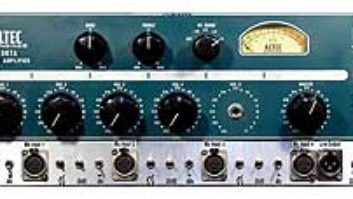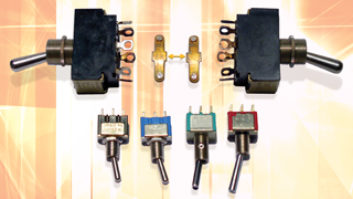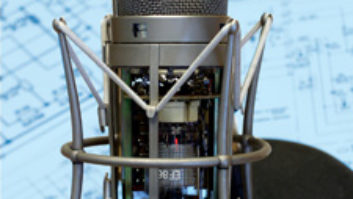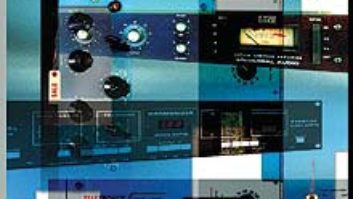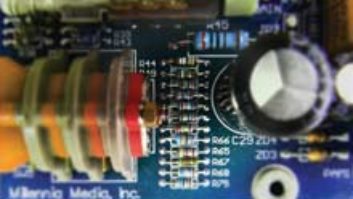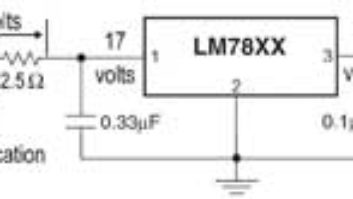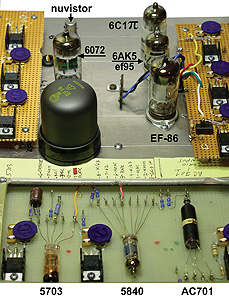
Figure 1: My D.I.Y. “Head Amp Evaluator” design will ultimately accommodate most of the common condenser mic tubes. A signal can be injected into all, with the output noise and response of each tube selectable via a rotary switch.
Tube replacement is so physically easy that it’s often the first solution when something goes wrong. If a new tube doesn’t improve the sound, reduce the noise or eliminate the funky distortion, you’ll know to dig deeper into the circuitry—or have someone with experience do the digging. While externally friendly, safe and “warm,” tube circuits have some seriously high voltages (300V and higher) and multiple power supplies on the inside, so be careful when digging.
In a condenser mic, the “head amp” tube has to be quiet; microphonics (the term used to describe a tube’s mechanical sensitivity) are far less important than in a combo guitar amp (a single cabinet that contains amp and speaker), but all of this comes before sonic qualities. Having tested at least 1,000 tubes for microphone applications, I am surprised by the number that are microphonic almost as much as you might be surprised that a newly made EH6072 could be quieter than a GE 5-star version. Nothing is forever in tubeville.
That said, I built a simple “evaluator” (see Fig. 1) that allows me to scrutinize head amp tubes more closely. While inspired by the need to audition subminiature tubes (AC701, 5703) outside of the narrow confines of some condenser mics, I also added sockets to test most varieties—from the venerable EF- and VF-14 to the 7-pin miniatures, as well as the 6072 and EF86. I have yet to find a non-microphonic EF86—NOS or new—but there’s still time.
WHERE AND WHAT TO BUY
Buying a vacuum tube is not as easy as buying an iPhone—although the process can be similarly spendy. Before finding a good match, musicians audition several instruments; the same is true for vacuum tubes, which are available for purchase all over the Web at widely variable prices. Plain-vanilla sites will simply list the tubes and prices; others will provide more detailed descriptions. Most are selling the same newly manufactured tubes from Russia (Sovtek, Electro-Harmonix, Svetlana, Mullard, Tung-Sol, Genalex), the Slovak Republic (JJ) and China (Shuguang, Valve Art).
NOS tubes are genuinely in short supply, some shorter than others as reflected by their prices. Some sellers practice all sorts of voodoo, such as freezing NOS tubes to realign all the metal parts. Others are simply re-branding some of the previously mentioned “parts.” I’d like to think that re-branding came after the tubes were tested and met a certain standard.
The services you want to pay for are matching (for power tubes) and, while rarely available, noise and microphonics testing. Microphonics are not a number, but simply the results of a go/no-go tapping test. Low microphonics are especially critical when high-gain circuits meet combo amps.
A vacuum tube’s Mean Time Before Failure (MTBF) is short compared to a transistor or IC. That said, a quality re-seller should guarantee functionality and performance, and provide a replacement or your money back—assuming the problem is discovered within the seller’s very limited time window (and this may be further limited to preamp tubes only). So if you buy spare tubes in advance, test them right away.
Testing for noise and microphonics is the easiest D.I.Y. process; the main prerequisite is having multiple tubes from which to choose. My money is on buying more than what is needed. The degree to which the end-user can further analyze a vacuum tube is pretty much limited to the one-at-a-time auditioning process, which, unless you’ve got an A/B switch, will only reveal the most obvious sonic differences.
The next step is test equipment. Tube testers essentially offer a more sophisticated go/no-go test. An oscillator and oscilloscope will reveal basic in-circuit performance. A dB meter and distortion analyzer will assist in quantifying what you hear. Beyond that, the one luxury all tube geeks would love to have is a curve tracer, a device that can reveal a tube’s full performance capabilities in such detail as to allow (with sufficient quantities) a perfect match to be found.
WHAT MANUFACTURERS DO
We all know that buying in quantity can reduce per-unit cost. When combined with the need for consistent performance (and the luxury of time), the lot can be sorted, graded and even matched. Geeks need quantifiable evidence, hence the need for test equipment. In some cases, it’s even necessary to build custom test fixtures. This is especially true for vacuum tubes because test equipment manufacturers don’t see “tube users” as a viable market.

Figure 2: The performance curves of a 6386 twin-triode (red) and a 6BA6 wired as a triode (green) are nearly identical—closer than samples of the same type might be—even if this image is too small to reveal subtleties.
For mission-critical tubes, people like Oliver Archut of TAB Funkenworks will tell you that no modern tube can match NOS, and this may be especially true for the tubes required by the V72-style preamps that his company manufactures. Larry Janus of Tube Equipment Corporation relies on a quartet of tightly matched NOS 6BA6 tubes to replace the two 6386 tubes (per channel) in his Fairchild 670 re-creation, the SR-71.
In both cases, being a geek on a mission requires some prescient urge to hunt and gather, plus a lifelong research quest for documentation, NOS alternatives, custom-made parts and the ability, desire and tenacity to D.I.Y. on a grand scale. Archut learned to make/rewire transformers while Janus modified/augmented a tube tester to improve the speed and quality of the matching process. (See Fig. 2.)
Tube matching is essential in Fairchild-type compressor designs. “In remote-cut-off [variable Mu-style] compression circuits, there’s a need to match tubes at multiple bias points,” Janus explains. “Any imbalance between the tubes allows the control voltage to leak into the audio, which reveals itself as ‘thumping’ during gain reduction. Unlike a fixed-bias circuit [such as a power amp], the remote cut-off stage is shifting bias during gain reduction and the pair of tubes needs to track at many bias points. In addition, both channels of a stereo remote cut-off compressor must track equally well, or image shift will occur during gain reduction.”
Although their products are very different, EveAnna Manley (Manley Labs) and Mike Spitz (ATR Magnetics) have similar D.I.Y. stories. “We have loads of experience with specific tube types—especially brands and lots that work exceptionally well in our circuits,” states Manley in her Website’s FAQ. “We have thousands of them in stock so that, after testing, we get a good enough yield to be able to sustain production for many, many years to come. Not all tubes are created equal. You can get a 1,000-piece lot of 1960s Phillips 12AT7s that are absolute trash. Brand-new Ei’s from Yugoslavia will whoop ’em performance-wise and sonically.” Manley also cautions against shopping for “highly prized” tubes on eBay, instead recommending www.upscaleaudio.com for pre-tested replacement tubes. Upscale’s site also contains a lot of useful general information on tube technology.
THE HUMBLE SERVICE BENCH
When a tube is not the problem, a tired, old carbon resistor or capacitor might be. If a high-gain circuit is noisy, then the plate resistor is suspect and should be replaced. If the sound is thin or oddly distorted, the coupling capacitor between stages—from plate to grid—may be the culprit and should be changed.
For more fun with Eddie Ciletti, visit www.tangible-technology.com.

